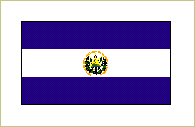|
|
|
|
|
El Salvador, country in northeastern Central America, south and west of Honduras. The smallest and most densely populated Central American state, it has a total area of 21,041 sq km (8124 sq mi). San Salvador is the capital and largest city. Land and Resources, El Salvador consists of a central plateau that lies between two volcanic mountain ranges. The highest point is the Santa Ana volcano, 2385 m (7825 ft) above sea level. Earthquakes and volcanic eruptions are common. The country lies within the tropics; the climate, however, is moderated in many regions by high elevation. The country's natural resources are primarily agricultural. Population, More than 90 percent of El Salvador's population (2005 estimate, 6,705,000) is mestizo, that is, of mixed Spanish and Native American ancestry. Spanish is the official language; the principal religion is Roman Catholicism. Schooling is free and compulsory in the elementary grades. Government, The 1983 constitution established an elective presidency, with a civilian chief executive popularly elected to a five-year term. It also established an 84-member legislature. For local government the country is divided into 14 departments, each with an appointed governor. |
|
|
......Prior to the arrival of the Spanish in the early 16th century, El Salvador was inhabited by several Native American tribes. It was then part of the Spanish holdings in the Americas for about 300 years before forming part of the Mexican Empire and the United Provinces of Central America for brief periods of time. ......El Salvador gained independence in 1841; during the remainder of the 19th century its history was turbulent, with much conflict. In the 20th century the country stabilized. The economy grew, as the production and export of coffee became the leading industry, and rail and port facilities were built. Most people, however, remained poor. ......Beginning in the late 1940s, the demands of the poorest classes for economic and social reforms became more urgent. They were met with little response, however, from the series of military and civilian juntas that held power. By 1979 guerrilla warfare had broken out in many areas, beginning a 12-year civil war. In 1980, Salvadoran Archbishop Oscar Arnulfo Romero, a vocal advocate for the country's poor and politically powerless, was assassinated. In response to increasing government repression, a number of left-wing guerrilla organizations formed the Farabundo Martí National Liberation Front (FMLN) later that year. ......In 1989 the FMLN launched a major offensive that pushed the Salvadoran government to participate in a series of new peace talks. The signing of a treaty in 1992 ended the long civil war, in which an estimated 75,000 people had been killed, most of them civilians. In 1994 a United Nations (UN) report stated that land and housing promises made to former FMLN rebels, now converted to a traditional political party, were not being carried out in concordance with the 1992 treaty. In protest, 500 former FMLN soldiers occupied the legislature and called for the full completion of the treaty. They left peacefully two days later after receiving assurances from the government. |
There are no web pages I know of (other than mine) dedicated to Enrique Alvarez. However, innumerable interesting sites deal with all aspects of El Salvador and Central America.
Three Salvadoran daily newspapers are on line. The only one not leaning far to the right politically is Co-Latino.
The Latin America Institute at the University of Texas has compiled many links to sources of information about El Salvador. Look here.
There are a number of U.S. organizations which work in solidarity with El Salvador. The Foundation for Self Sufficiency in Central America (FSSCA) was founded by a former Salvadoran priest who was a pioneer in developing Christian Base Commnities in his country.
The CIS (Centro de Intercambio y Solidaridad) is based in San Salvador and offers interesting learning and volunteering programs. Its web site is here.
Anothe well-known organization is CISPES (Committee in Solidarity with the People of El Salvador) which supports the political program of the FMLN.
|
|

